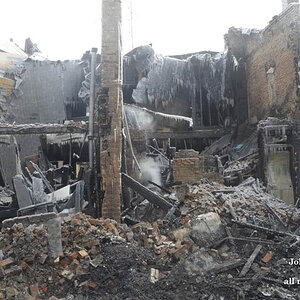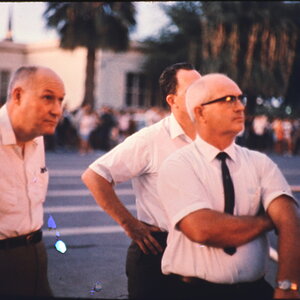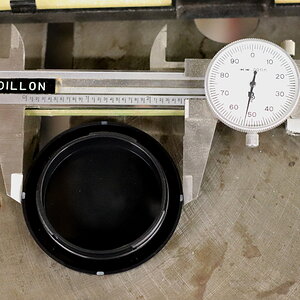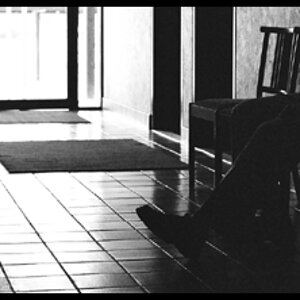I have been thinking about getting my wife another lense. It has been my impression that any lense used on a digital format is multiplied by 1.5 then I check this http://www.tamron.com/lenses/prod/assets/pdfs/18_200_A014.pdf. What are they talking about 18mm is the same as 28mm in film on this lense ? Isn't that the opposite or there is a different standard on field of view angles from digital and film.
Navigation
Install the app
How to install the app on iOS
Follow along with the video below to see how to install our site as a web app on your home screen.

Note: This feature currently requires accessing the site using the built-in Safari browser.
More options
You are using an out of date browser. It may not display this or other websites correctly.
You should upgrade or use an alternative browser.
You should upgrade or use an alternative browser.
I still don't get this the 1.5x factor film to digital
- Thread starter Cyrus
- Start date
markc
TPF Noob!
- Joined
- Mar 8, 2004
- Messages
- 4,237
- Reaction score
- 6
- Location
- Rochester, NY Velocity: Unknown
- Website
- www.markcarpenter.com
- Can others edit my Photos
- Photos NOT OK to edit
Your link is a bit mangled there, and I couldn't get the PDF to come up on my machine from the correct link.
Nikons are 1.5x. Canons are 1.6x. Medium Format cameras are the other way from 35mm. A 6x6 camera is 0.6x.
This might help: http://jimdoty.com/Digital/fov_crop/fov_crop.html
Basically, a lens is a lens. The actual focal length never changes, just the FOV.
Nikons are 1.5x. Canons are 1.6x. Medium Format cameras are the other way from 35mm. A 6x6 camera is 0.6x.
This might help: http://jimdoty.com/Digital/fov_crop/fov_crop.html
Basically, a lens is a lens. The actual focal length never changes, just the FOV.
Thanks for the link. So, If I am starting to understand this, the digital 18mm lenses give you a field of view of 76 degrees but in film you get 76 degrees at 28mm. 18mm digital it is not wide angle but instead a farce; no different than film 28mm. Someone correct me if I am mistaking. So what do you do to get wide angle(landscape) shots with a D50 like you would if you had a a film 19-35mm lense that gave you 63 degrees at 30' ?
markc
TPF Noob!
- Joined
- Mar 8, 2004
- Messages
- 4,237
- Reaction score
- 6
- Location
- Rochester, NY Velocity: Unknown
- Website
- www.markcarpenter.com
- Can others edit my Photos
- Photos NOT OK to edit
Buy an expensive ultra-wide lens. 
18mm is still wide, it's just not all that wide.
Hey, at least you aren't using one of the compact digitals. For the 1/1.8" sensor cameras, 9mm is "normal"! They have 4mm-28mm zooms.
This is why you are seeing more digital lenses showing up for the DSLRs. They protrude into the body so they can't be used with film cameras (the mirror hits), but it allows them to make wider lenses cheaper.
18mm is still wide, it's just not all that wide.
Hey, at least you aren't using one of the compact digitals. For the 1/1.8" sensor cameras, 9mm is "normal"! They have 4mm-28mm zooms.
This is why you are seeing more digital lenses showing up for the DSLRs. They protrude into the body so they can't be used with film cameras (the mirror hits), but it allows them to make wider lenses cheaper.
ksmattfish
Now 100% DC - not as cool as I once was, but still
- Joined
- Aug 25, 2003
- Messages
- 7,019
- Reaction score
- 36
- Location
- Lawrence, KS
- Website
- www.henrypeach.com
- Can others edit my Photos
- Photos NOT OK to edit
18mm digital it is not wide angle but instead a farce; no different than film 28mm.
Why is it a farce? And most people consider the angle of view from a 28mm focal length lens on 35mm to be fairly wide angle.
Don't worry about focal lengths. It's a lousy way to describe a lens. It only works when everyone is using the same format, and there are at least a dozen out there these days. Just choose your lenses for the angle of view the lens provides for the format you're using.
Soocom1
Been spending a lot of time on here!
- Joined
- Feb 27, 2006
- Messages
- 3,253
- Reaction score
- 1,489
- Can others edit my Photos
- Photos NOT OK to edit
Field of view is only part of the issue.
You also have to consider this:
Take a picture with a DSLR with an APS sized sensor.
Take another picture at the same spot with the same lens on a 35mm or full frame camera. When you enlarge the image to say a 4x6, the image of the APS sensor has to be enlarged 1.5 times MORE than the 35mm image.
Because the APS sized sensor is 1.5 times smaller than the full frame sensor (35mm), the total enlargement of a picture taken with an APS sized sensor will have 1.5 times MORE “zoom effect” compared to the 35mm.
So a picture taken with an 18mm lens on a DSLR will enlarge to the equivalent of a 28mm lens on a full frame picture taken at the same distance
You also have to consider this:
Take a picture with a DSLR with an APS sized sensor.
Take another picture at the same spot with the same lens on a 35mm or full frame camera. When you enlarge the image to say a 4x6, the image of the APS sensor has to be enlarged 1.5 times MORE than the 35mm image.
Because the APS sized sensor is 1.5 times smaller than the full frame sensor (35mm), the total enlargement of a picture taken with an APS sized sensor will have 1.5 times MORE “zoom effect” compared to the 35mm.
So a picture taken with an 18mm lens on a DSLR will enlarge to the equivalent of a 28mm lens on a full frame picture taken at the same distance
ksmattfish
Now 100% DC - not as cool as I once was, but still
- Joined
- Aug 25, 2003
- Messages
- 7,019
- Reaction score
- 36
- Location
- Lawrence, KS
- Website
- www.henrypeach.com
- Can others edit my Photos
- Photos NOT OK to edit
Then take a picture with a medium format or large format camera with the same focal length. The field of view has changed again, but this time you will have less enlarging necessary to get the same sized print.
Photogs who have used multiple film formats have been dealing with this for almost one hundred years. I don't understand why the introduction digital makes it so confusing?
Focal length and format size work together to create the angle of view.
A "normal" angle of view is about 50 degrees. Below are the focal lengths that give that approximate angle of view for different formats. All of these focal length/format combinations would take pretty close to the same photo with the photog standing in the same place. You could make a similar list for a 75 degree angle of view that started out with APS-C = 18mm, and 35mm format = 28mm, and 6x7cm format = 55mm, etc...
31mm focal length gives a "normal" angle of view for x1.6 APS-C format.
50mm focal length gives a "normal" angle of view for 35mm format.
75mm focal length gives a "normal" angle of view for 6x4.5 cm format.
80mm focal length gives a "normal" angle of view for 6x6 cm format.
105mm focal length gives a "normal" angle of view for 6x7 cm format.
150mm focal length gives a "normal" angle of view for 4x5 inch format.
300mm focal length gives a "normal" angle of view for 8x10 inch format.
Enlargement ratio has nothing to do with focal length or angle of view, only format size.
Photogs who have used multiple film formats have been dealing with this for almost one hundred years. I don't understand why the introduction digital makes it so confusing?
Focal length and format size work together to create the angle of view.
A "normal" angle of view is about 50 degrees. Below are the focal lengths that give that approximate angle of view for different formats. All of these focal length/format combinations would take pretty close to the same photo with the photog standing in the same place. You could make a similar list for a 75 degree angle of view that started out with APS-C = 18mm, and 35mm format = 28mm, and 6x7cm format = 55mm, etc...
31mm focal length gives a "normal" angle of view for x1.6 APS-C format.
50mm focal length gives a "normal" angle of view for 35mm format.
75mm focal length gives a "normal" angle of view for 6x4.5 cm format.
80mm focal length gives a "normal" angle of view for 6x6 cm format.
105mm focal length gives a "normal" angle of view for 6x7 cm format.
150mm focal length gives a "normal" angle of view for 4x5 inch format.
300mm focal length gives a "normal" angle of view for 8x10 inch format.
Enlargement ratio has nothing to do with focal length or angle of view, only format size.
earthairfire
TPF Noob!
- Joined
- Jan 8, 2007
- Messages
- 6
- Reaction score
- 0
- Can others edit my Photos
- Photos OK to edit
Remember it's only an "equivalent" focal length. A 18mm lens will ALWAYS be an 18mm lens, just your picture will look different if taken on a 35mm film (or full frame DSLR) as opposed to a "crop sensor" DSLR.
Picture this:
Take a picture on a 35mm film camera using an 18mm lens
Take a picture on a cropped sensor DSLR using an 18mm lens
Look at both pics - the field of view is bigger (i.e. a wider angle of view) on the 35mm film picture, although both used the same lens. If you had taken a picture on the film camera using a 28mm lens (18x1.6), you would have got a SIMILAR picture to 18mm cropped sensor shot. I say similar, because the change in focal length between a 18mm and 28mm lens will affect more than the field of view (look into foreshortening and depth of field if you want to know more).
Hope this makes it easier to understand, and not more complex!!
Tim
Picture this:
Take a picture on a 35mm film camera using an 18mm lens
Take a picture on a cropped sensor DSLR using an 18mm lens
Look at both pics - the field of view is bigger (i.e. a wider angle of view) on the 35mm film picture, although both used the same lens. If you had taken a picture on the film camera using a 28mm lens (18x1.6), you would have got a SIMILAR picture to 18mm cropped sensor shot. I say similar, because the change in focal length between a 18mm and 28mm lens will affect more than the field of view (look into foreshortening and depth of field if you want to know more).
Hope this makes it easier to understand, and not more complex!!
Tim
The last thing I wanted to do was give my wife less capability by getting her a D50. I read abit and started to realize what you have started to explain, it has been a disappointing realization. I was hoping that a 18-200 lense would work out great by replacing her 19-35 and 28-200. However, it seems that a 18-200 would give the same effeteness as a 28-300 in 35mm terms. Looks like I'll recommend that she keep her n75 for landscapes for the time being. It expected that a lense would be the same regardless of the camera. This format thing was unexpected. Lasty this information that you all have posted is not easily or readily found. Someone should do a help guide and sticky it in a good place.
I disagree that the information is not readily available. Every camera manufacturer tells you "crop factor" of their sensor. Take a look at Nikon's website - the description for any of their 'digital' DX lenses tells you the 'equivalent' for the 35mm format. The meaning and effect of "crop factor" or "effective focal length" is explained and discussed daily on many sites and forums. It could be stickied, but then so could any number of other basic concepts, which would leave us little room for anything else.
You don't have less capability with your D50. What you have is less wide-angle capability with an 18mm lens than you would with the 35mm format. For something roughly equivalent to the 19-35mm lens you used with 35mm film, you would need something like a 12-24mm. This will unfortunately set you back a lot more than a 19-35mm. As you said it's probably best for now to keep using film for when the 18-200 on the dSLR won't go wide enough.
You don't have less capability with your D50. What you have is less wide-angle capability with an 18mm lens than you would with the 35mm format. For something roughly equivalent to the 19-35mm lens you used with 35mm film, you would need something like a 12-24mm. This will unfortunately set you back a lot more than a 19-35mm. As you said it's probably best for now to keep using film for when the 18-200 on the dSLR won't go wide enough.
I disagree that the information is not readily available. Every camera manufacturer tells you "crop factor" of their sensor.
I was thinking that a 18mm lense was a 18mm lense and that 18mm was wide angle reguardless. This seemed like a reasonable assumption. Sigma, doesn't make a deal of this. Nikon mentions it in passing. Tamron is the one that made great pains in enlightening you. This little nugget gets left out in the 1.5 factor with the digital camera(1.6 with Cannon). So, I thought 28-200 was going to be a 32-300 so if I got a 18-200 digital lense I would get the wide angle back. I am still learning and this is something new for me.
I was thinking last night. Now, that I understand the crop factor that you have in different format sensors effecting the view angle and effective length of the lense. I realized I don't know what make a lense 18-200 or 18-55 ? How do they determine the specs of the lense when a lense preforms differently ?
markc
TPF Noob!
- Joined
- Mar 8, 2004
- Messages
- 4,237
- Reaction score
- 6
- Location
- Rochester, NY Velocity: Unknown
- Website
- www.markcarpenter.com
- Can others edit my Photos
- Photos NOT OK to edit
Is is.I was thinking that a 18mm lense was a 18mm lense
That will change depending on sensor size.and that 18mm was wide angle reguardless.
The thing is, 18mm is still considered wide for both 35mm film and the cropped sensor DSLRs. It's just not quite as wide. It would be considered telephoto for compact digital and ultra-wide for medium format, but since the lens will never be put on those cameras, there's no mention of that fact. There's no need to. The only two lenses I see worth mentioning the change of type is a 35mm lens, which is wide on a 35mm film camera and "normal" on a cropped digital, and a 50mm lens, which is "normal" for 35mm film and a telephoto for the cropped digitals. The 18mm is still a wide angle on both, just as a 200 is a telephoto on both.
The rest of the time, it's about knowing your equipment. I know it can be frustrating trying to find info sometimes, especially when you don't even know you need it, but the 1.5 and 1.6 crop factor is an important aspect of the body, not the lens. Some have 1.3, and there may even be other crop factors out there. It's something that I see in discussions about the body, and I don't think I've seen a spec list that doesn't include the body's crop factor.
In the medium format realm, and even more so in large format, the same lenses will get used with different film backs that might be holding different sized film. You might be shooting 6x6 one hour, and then switch over to 6x4.5 the next. There are some odd film sizes out there, and the lens manufacturers can't be sure what you are going to be using or cover all of them in their literature. The lens is a lens. They have specific kinds of mounts, but they can't be sure of all of the cameras with that kind of mount and what their crop factor is going to be.
This is a bit of a stretch, but it's a bit like how light bulbs only say what type they are and what wattage they are. It's up to the lamp instructions to say what kind of bulb you need and the max wattage they can handle is. If you put all of the lamps that the bulb could be used in on the bulb packaging, you would need very fine print, and it would never be up to date.
I'm not blaming you for not knowing, I'm just saying that blaming the lens manufacturers seems a bit misplaced to me. There is precedence for this already in medium and large format. The trick is that so many people are coming into digital that aren't aware of this.
I realized I don't know what make a lense 18-200 or 18-55 ? How do they determine the specs of the lense when a lense preforms differently ?
Here is the formula for focal length. With a zoom, they design the lens so that moving optical parts will change the focal length. With a prime, they design the lens for a single focal length.
I'm not blaming you for not knowing, I'm just saying that blaming the lens manufacturers seems a bit misplaced to me. There is precedence for this already in medium and large format. The trick is that so many people are coming into digital that aren't aware of this.
Live and learn, I must.
 Just that I have been pulling little tidbits of info from here and there to get a good understanding. At first I knew that there was a crop factor which was OK. Then you really had to dig around to find out that you didn't replace your wide angle losses buy getting a digital lense. That was the disappointing realization that a specially designed lense didn't give you back what you had with film. I mean they all talk about how it fits the sensor, I thought it would take you back to square one. My bad assumption.
Just that I have been pulling little tidbits of info from here and there to get a good understanding. At first I knew that there was a crop factor which was OK. Then you really had to dig around to find out that you didn't replace your wide angle losses buy getting a digital lense. That was the disappointing realization that a specially designed lense didn't give you back what you had with film. I mean they all talk about how it fits the sensor, I thought it would take you back to square one. My bad assumption.thebeginning
TPF Noob!
- Joined
- Jan 10, 2005
- Messages
- 3,795
- Reaction score
- 30
- Location
- Texas
- Website
- www.danielcolvinphotography.com
- Can others edit my Photos
- Photos NOT OK to edit
Live and learn, I must.Just that I have been pulling little tidbits of info from here and there to get a good understanding. At first I knew that there was a crop factor which was OK. Then you really had to dig around to find out that you didn't replace your wide angle losses buy getting a digital lense. That was the disappointing realization that a specially designed lense didn't give you back what you had with film. I mean they all talk about how it fits the sensor, I thought it would take you back to square one. My bad assumption.
well, when you think about it, the lens you bought does give you back what you had with film...with an equivalent lens with film. an 18-200 on a cropped sensor is more or less replacing a 28-300 lens on a 35mm film camera.
Similar threads
- Replies
- 65
- Views
- 6K



![[No title]](/data/xfmg/thumbnail/31/31092-7ba73f844ad8efedd3d5fd94799a866d.jpg?1619734609)


![[No title]](/data/xfmg/thumbnail/31/31743-3b294ee78fc71e7bfc025b01eafb0c2d.jpg?1619734986)



![[No title]](/data/xfmg/thumbnail/39/39476-6e232ea205145ad1a1da0690d7617642.jpg?1619739045)

